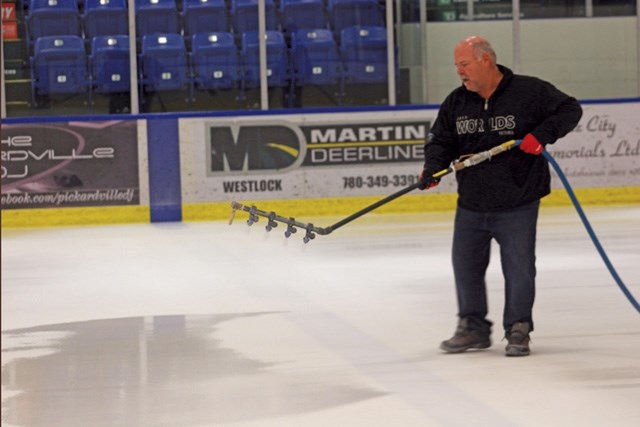The Rotary Spirit Centre ice rink was a busy place this last weekend, in spite of the fact there was no hockey schedule.
Workers and volunteers have tirelessly been putting in long days to get the ice surface ready for the highly anticipated bonspiel Feb. 8-12.
Canadian Curling Association chief ice technician Jamie Bourassa said that curling ice is quite different from skating ice.
“Curling ice has to be as level as possible,” explained Bourassa, who has been setting up curling rinks for 40 years.
“Hockey ice ... just has to be flat, so hockey ice can be high on one end and low on the other. Curling ice can’t. Temperatures vary quite a bit too. Also with curling ice, we have to put beads of water on top for the rocks to travel on.”
The temperature of the ice will vary depending on the temperature and humidity of the building.
To begin the process of laying the ice for curling, the technicians first paint the normal rink ice white. Once the ice has been painted, sealant is laid out to keep the paint from chipping off. Then, rings and lines for the curling lanes are marked out and painted onto the ice.
From there, a second layer of ice is poured and molded into the curling ice.
“Firstly, you’ve got to make sure you’ve got good quality water,” he said. “The biggest things in buildings like this are airflow, humidity, temperatures, dealing with those things. The rest of it is stuff we do every day, preparing ice, scraping ice and pebbling.”
The entire process will take a sizeable crew four very long days to complete.
“There’s probably about 10 volunteers, plus myself and two other guys that work with me,” said Bourassa.
“It’s going to take us four days until we’re to the point where we can curl on it, and we’re working 16-hour days.”
Part of the challenge — and fun — for Bourassa is figuring out the individual character of an arena as he sets the ice up.
“Every arena we go into has its own idiosyncrasies, whether it be airflow or just trying to control temperatures and humidity,” he said. “You’ve got to solve all those problems before the tournament starts.”
Humidity is the biggest factor Bourassa says he has to watch out for.
“If it’s humid in the arena, frost starts building up and then the rocks won’t travel across the ice. It’s a nightmare. So any possible situation that could come up, I try to simulate that or stop it before it happens,” he said.
For all the effort that goes into putting the curling rink together, taking it apart is easy.
Bourassa estimates that 90 per cent of the rink could be taken down in less than an hour.



